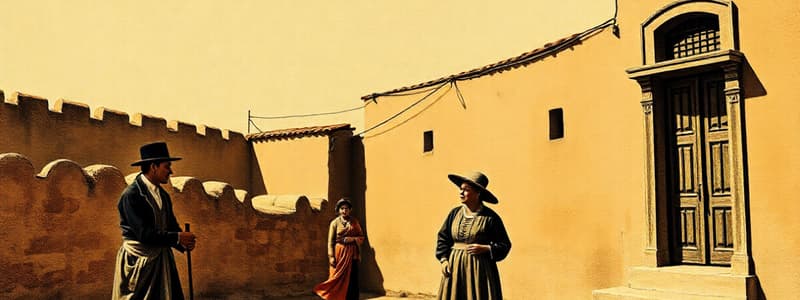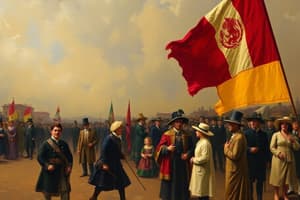Podcast
Questions and Answers
What is the main purpose of the text?
What is the main purpose of the text?
- To explain the political structure of Mexico
- To detail the trading activities of the indigenous population of Mexico
- To describe the abundant food resources of Mexico (correct)
- To highlight the impressive achievements of foreign visitors in Mexico
What aspect of Mexico is particularly emphasized in the text?
What aspect of Mexico is particularly emphasized in the text?
- The diverse array of agricultural products (correct)
- The military strength of its government
- The technological advancements of its people
- The country's bustling trade with foreign nations
What did foreigners observe in Mexico?
What did foreigners observe in Mexico?
- A high level of technological advancement
- An efficient system of government
- A high quality of food and other resources (correct)
- A shortage of food resources
What kind of resources did foreigners remark on?
What kind of resources did foreigners remark on?
What is the tone of the text?
What is the tone of the text?
Which of the following accurately describes the main focus of the text?
Which of the following accurately describes the main focus of the text?
What is the significance of the phrase "1,000 lllil5lers' and dottu......,,,.r;.F'" in the text?
What is the significance of the phrase "1,000 lllil5lers' and dottu......,,,.r;.F'" in the text?
Based on the text, what is the author's attitude towards the historical events described?
Based on the text, what is the author's attitude towards the historical events described?
What is the most likely reason the author included the phrase "however, remains the I 1i5roriia 1/l!Tdddem de la" in the text?
What is the most likely reason the author included the phrase "however, remains the I 1i5roriia 1/l!Tdddem de la" in the text?
What is hinted at by the phrase "conq11esr with the diligent srndi" in the text?
What is hinted at by the phrase "conq11esr with the diligent srndi" in the text?
What was the primary driving interest behind the education system established after the fall of Tenochititlan?
What was the primary driving interest behind the education system established after the fall of Tenochititlan?
How did the culture of New Spain influence daily life?
How did the culture of New Spain influence daily life?
What role did the church play in the educational framework after the fall of Tenochititlan?
What role did the church play in the educational framework after the fall of Tenochititlan?
Which subjects were emphasized in the educational curriculum during the early years of New Spain?
Which subjects were emphasized in the educational curriculum during the early years of New Spain?
What was a significant outcome of the educational policies implemented in New Spain?
What was a significant outcome of the educational policies implemented in New Spain?
Flashcards
Education in New Spain
Education in New Spain
The process of teaching and learning in New Spain, primarily focused on religious education and the Spanish language.
Who was Fray Bartolomé de las Casas?
Who was Fray Bartolomé de las Casas?
A key figure in the development of education in New Spain, founding the first formal schools for indigenous populations.
What was the primary goal of education in New Spain?
What was the primary goal of education in New Spain?
The primary focus of education in New Spain was to instill religious values and knowledge, and to spread Christianity.
What language were indigenous children taught in?
What language were indigenous children taught in?
Signup and view all the flashcards
What were the main subjects taught in New Spain schools?
What were the main subjects taught in New Spain schools?
Signup and view all the flashcards
Translation
Translation
Signup and view all the flashcards
Personal Account
Personal Account
Signup and view all the flashcards
Graphic Description
Graphic Description
Signup and view all the flashcards
Emphasis
Emphasis
Signup and view all the flashcards
Biographical Information
Biographical Information
Signup and view all the flashcards
Provisioning
Provisioning
Signup and view all the flashcards
Outlying provinces
Outlying provinces
Signup and view all the flashcards
Foreigners
Foreigners
Signup and view all the flashcards
Excellence
Excellence
Signup and view all the flashcards
Pottery
Pottery
Signup and view all the flashcards
Study Notes
Education in New Spain
- Education in New Spain, initially focused on Hispanicizing indigenous populations, was encouraged by both the crown and the church.
- The primary goal was to Christianize the conquered people through the learning of Spanish.
- This approach also facilitated assimilation of Spanish culture.
- In contrast to Spain, education in New Spain wasn't a state responsibility. Instead, it was largely a concern of the church at the primary and secondary levels.
- The crown was primarily involved in higher education (universities) to prepare individuals for bureaucratic careers.
- The Catholic Church also placed emphasis on higher education for clergy to educate the colonies' clergy.
- The Franciscan friar, Pedro de Gante, was a key figure in early education.
- He established a school (San José) to teach native youth and vocational skills to adults, fostering assimilation into Spanish culture and skills.
- He personally oversaw the construction of over 100 chapels and churches.
Cultural Vitality
- The early years of the conquest in Mexico displayed a vibrant culture, despite challenges.
- Intellectual and cultural achievements were largely driven by the religious orders.
- Educated priests were the primary cultural influencers.
Notable Educational Institutions
- Santa Cruz de Tlatelolco: Founded in 1536 by Viceroy Mendoza and Bishop Zumárraga, this school provided higher education to native sons of nobles.
- A focus on reading, writing, Latin, rhetoric, logic, philosophy, music and native medicine ensured a strong education.
- Vasco de Quiroga: Known for his humanist approach to education.
- He implemented the establishment of schools and hospitals to enhance the quality of life among the indigenous.
- He established communal living and practical skills training focusing on self-governance.
- Jesuit San Gregorio Magno: Another notable institution which trained Nahuas (from 1586 to 1767) and provided education for other native populations.
- Colegio de San Juan de Letrán: Established to care for orphaned mestizos, the aim was to educate a future generation.
Scholarship and Literature
- The early scholarly work focused on documenting the lives and customs of the native population (history, anthropology) to support the goals of conversion.
- Key figures in this era include Motolinía, Alonso de Zorita, and Bernardino de Sahagún.
- Sahagún's work was groundbreaking, anticipating modern anthropological methods and gathering considerable indigenous information.
- Bernal Díaz del Castillo's detailed account of the conquest, the *Historia verdadera de la conquista de la Nueva España, * was a popular narrative.
- Later accounts like the Historia antigua de México by Clavijero exemplified the growing sophistication of Mexican historical writing.
Cultural and Daily Life
- Religious festivals and public spectacles were important diversions for the lower classes.
- Colonial elites attempted to maintain the social hierarchy through ritual performances.
- Colonial entertainment was a multifaceted and complex display which involved social hierarchies, performance and demonstrations, and public displays.
Studying That Suits You
Use AI to generate personalized quizzes and flashcards to suit your learning preferences.




